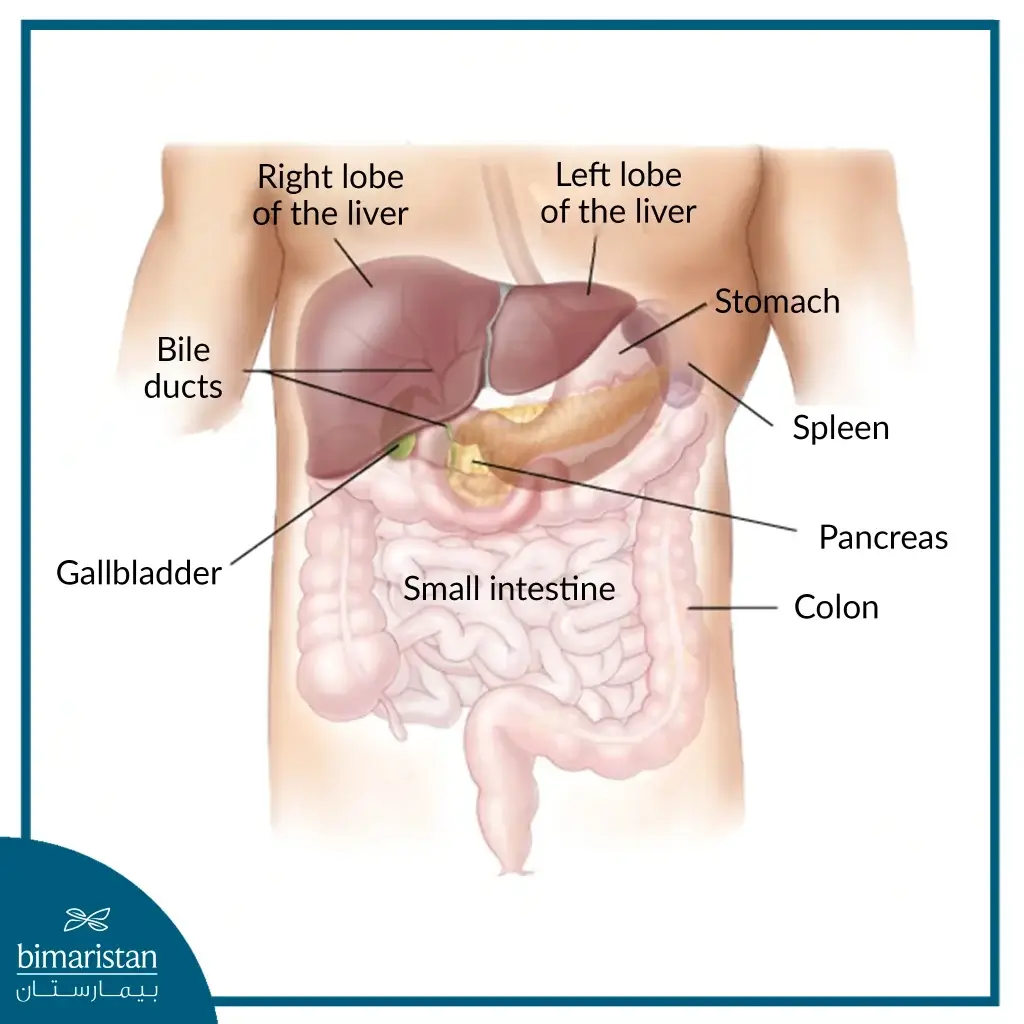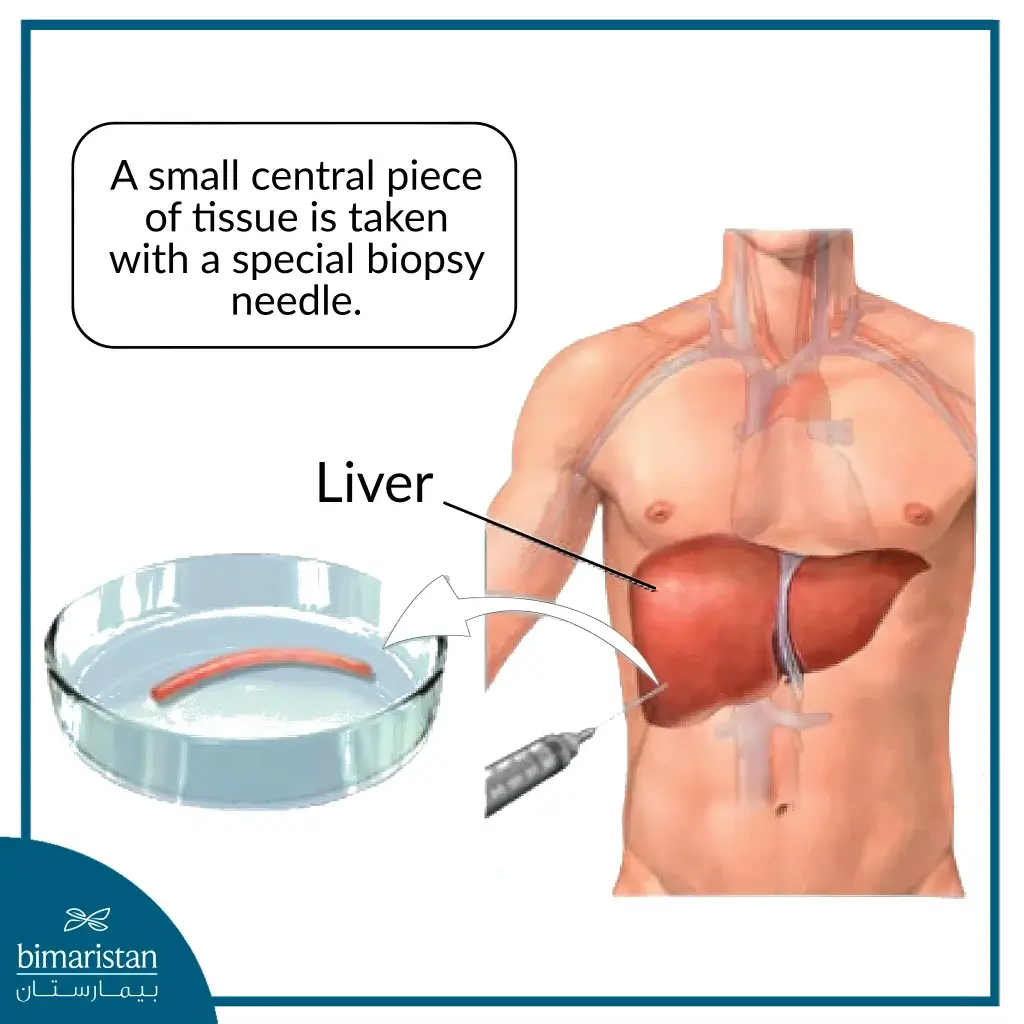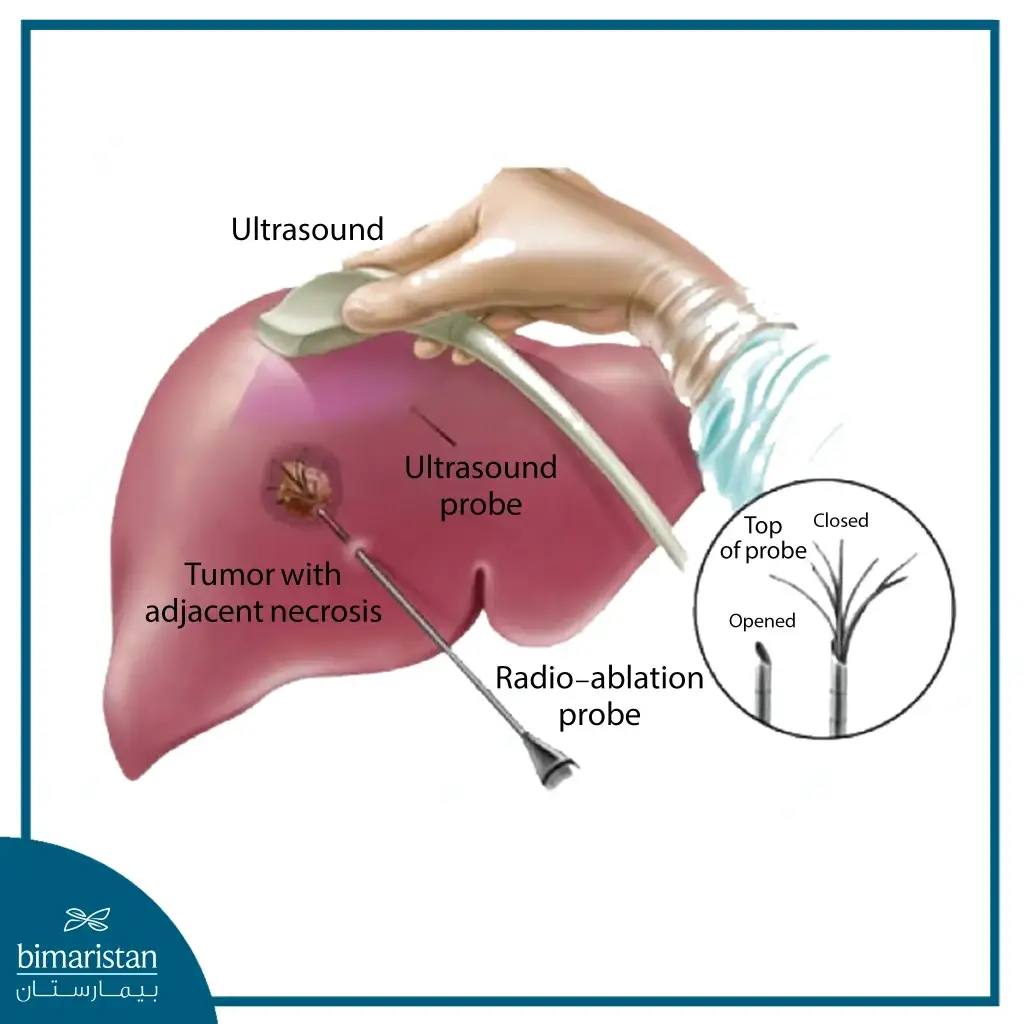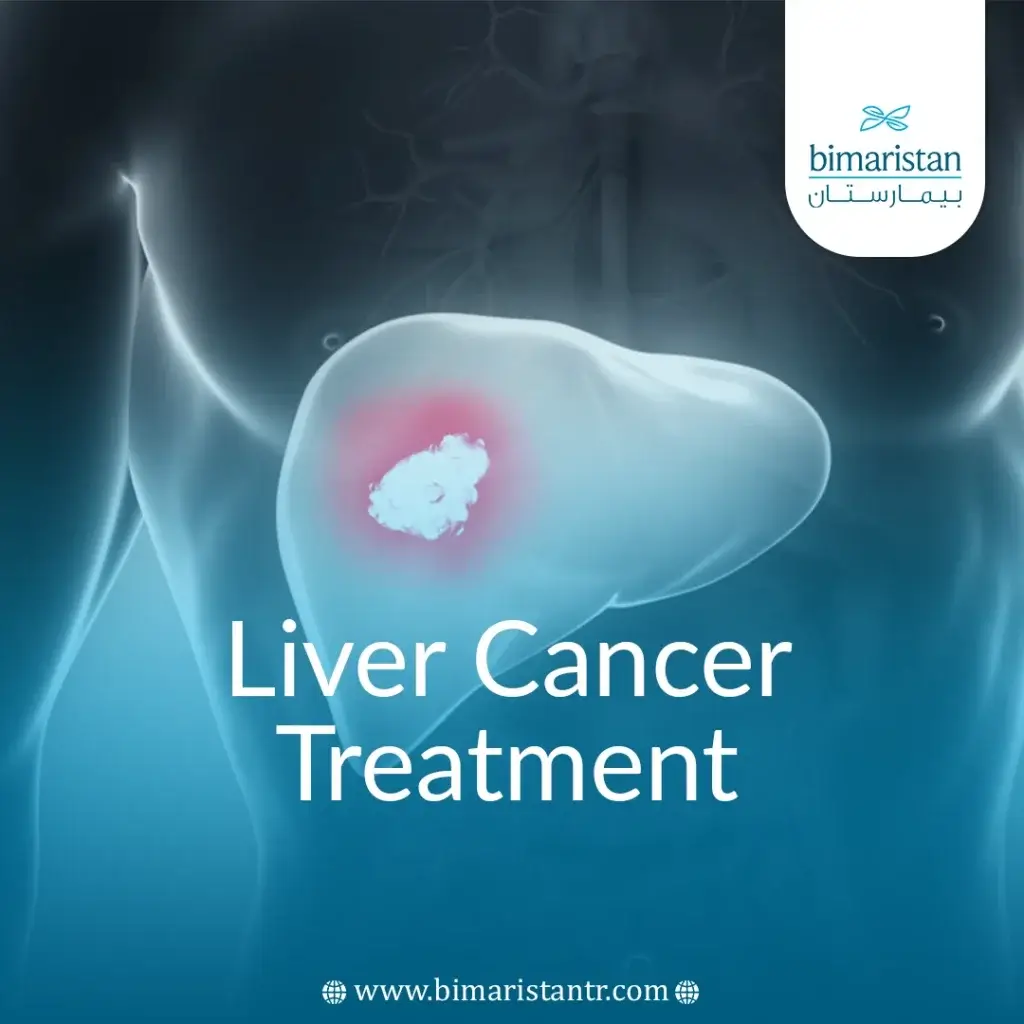No one can live without the largest internal organ in the body, and liver cancer is one of the most important diseases that threaten the function of this organ, so liver cancer treatment requires special care from the best doctors and the latest devices and treatment methods provided by Turkey.
Liver cancer is a significant cause of cancer deaths worldwide, responsible for more than 700,000 deaths each year.
What is the liver, and what is its function?
The liver is one of the most important organs and the largest gland in the body. It is located in the upper right side of the abdomen.
The liver consists mainly of hepatocytes, which are the main functional cells, and other types of cells, including cells that line the blood vessels and cells that line small tubes in the liver called bile ducts.
The bile ducts carry bile from the liver to the gallbladder or directly to the intestines.
This diversity in the cells that make up the liver is accompanied by a diversity in the tumors that affect it, whether benign or malignant.
These tumors have different causes, are treated differently, and each has a different prognosis and survival rate.
The liver is divided into sections, called lobes, whose function is to purify and filter the blood from toxins. The liver removes harmful substances (some medications, alcohol, etc.) from the blood, which are later excreted from the body as waste.
The liver also:
- Forms bile and transports it to the intestines to help digest fats.
- Digests and stores other nutrients from foods, such as sugar, which is stored as glycogen and provides the body with energy when needed.
- Manufactures many substances used in many body functions, including clotting factors.

What is liver cancer?
To treat liver cancer, we must understand what it is and how it occurs. Cancer is a disease that occurs when abnormal cells grow too quickly and leave less space for normal cells. The function of the affected organ may be lost if cancer cells overwhelm healthy cells.
So, when abnormal (cancerous) cells grow uncontrollably at the expense of any cell in the liver, we have liver cancer in its various types, which will be mentioned later in the article.
Liver cancer is classified into primary and secondary cancer based on where the tumor originated.
What is primary liver cancer, and what are its types?
It is a cancer that begins in the liver tissue at the expense of the multiple cells that make up the liver, and it has several types:
Hepatocellular Carcinoma (HCC)
This is the most common form of liver cancer in adults, accounting for 75% of all liver cancers.
Hepatocellular carcinoma can have different growth patterns:
- In some cases, it begins with a single tumor that grows larger, only later in the disease, spreading to other parts of the liver.
- In other cases, it begins with the appearance of many small cancerous nodes throughout the liver, not just a single tumor; this is most often observed in people with cirrhosis.
Cholangiocarcinoma
About 10% to 20% of cancers that begin in the liver are at the expense of the cells lining the bile ducts.
Bile ducts outside the liver or those inside it may be affected.
Liver Angiosarcoma
It is A rare type of liver cancer that develops from the cells lining the blood vessels of the liver.
It is believed that exposure to certain chemicals, such as vinyl chloride or Thorotrast, and some genetic conditions, such as hereditary hemochromatosis, increase the risk of developing this tumor.
These are rapidly developing tumors that quickly spread and are often widespread in the liver and cannot be removed by surgery, so radiation and chemotherapy are preferred here.
Hepatoblastoma
It is a rare type of liver cancer that affects children in particular, usually in children under the age of 3 or 4 years.
Hepatoblastoma cells resemble fetal liver cells.
About 2 out of 3 children with these tumors are successfully treated with surgery and chemotherapy. When the two treatments are combined with early tumor detection, the survival rate is greater than 85%.
The tumor becomes much more challenging to treat if it has spread outside the liver.
What is secondary liver cancer?
It is a cancer that starts somewhere else in the body and spreads to the liver. It accounts for the majority of cancer cases diagnosed in the liver in America and vice versa in Asia and Africa.
This type is also called metastatic liver cancer.
The cancer here can be named based on the location of the primary cancer, such as colon cancer with metastasis/liver metastasis when the metastasis is from the colon.
Causes of liver cancer and its risk factors
Any factor that increases your likelihood of developing the disease is called a risk factor.
However, the talk here remains relative, as the presence of one or more risk factors does not mean you will inevitably develop it, and vice versa.
One of the most critical risk factors for developing any cancer (including liver cancer) is aging, as the ability of cells to regenerate decreases and a disruption occurs in the work of programmed cell death, which is responsible for destroying deformed cells before they mature or those that have reached the end of their life span.
Other risk factors for liver cancer include:
Chronic (long-term) infection with hepatitis B or hepatitis C virus
These liver infections (hepatitis) lead to cirrhosis of the liver and are responsible for making liver cancer the most common cancer in many parts of the world.
Fibrosis
Fibrosis is a disease in which liver cells are damaged and replaced by scar tissue.
People with cirrhosis have an increased risk of liver cancer. Most people who develop liver cancer already have some evidence of cirrhosis.
Aflatoxins
These cancer-causing substances are made by a fungus contaminating unhealthily preserved foods such as peanuts, wheat, soybeans, nuts, corn, and rice.
Excessive drinking and smoking
Alcohol and smoking are significant causes of cirrhosis, which in turn increases the risk of liver cancer.
Non-alcoholic steatohepatitis
This is common in obese people, where fat builds up in the liver and can lead to inflammation and damage to liver cells.
Rare genetic diseases
- Tyrosinemia
- Alpha 1 antitrypsin deficiency
- Porphyria cutanea tarda
- Glycogen storage diseases
- Wilson’s disease
- Hereditary hemochromatosis
Treating these diseases or taking a vaccine against some of them reduces the likelihood of developing liver cancer.
Other less influential factors include:
- Obesity.
- Type 2 diabetes: People with this disease are obese in most cases, which increases the risk of liver cancer.
- Gender: Males are more affected than females due to quality of life and daily habits.
However, in most cases of liver cancer diagnosed, the cause is unknown.
Symptoms of liver cancer
In the early stages, the disease is often asymptomatic, but as the disease progresses, different symptoms may appear, including:
- Discomfort in the abdominal area, as liver cancer pain, is commonly concentrated in the upper right abdomen, near the right shoulder blade, and sometimes extends to the back. A visible mass may appear in the same place.
- Yellowing of the sclera and skin (jaundice).
- Unexplained weight loss.
- Chalky white stools.
- Dark yellow urine.
- Easy bruising and bleeding (due to a deficiency in the production of clotting factors).
- Nausea and vomiting.
- Fatigue and exhaustion.
Do not hesitate to contact us to learn more about the different symptoms of liver cancer depending on the stage of the liver tumor. The Bimaristan Center will answer any questions you may have.
Symptoms of benign liver cancer
In most cases, benign liver tumors do not cause any symptoms, and a person may not even know that they have them.
However, some symptoms may appear in some cases, especially if the tumor is large or proliferating. These symptoms include:
- Pain in the upper right abdomen: This is the most common symptom. The pain may be mild or severe and may radiate to the back or shoulder.
- Feeling full after eating only a small amount of food (early satiety): This is due to the tumor pressing on the stomach.
- Nausea and vomiting: This may be due to irritation of the stomach or intestines.
- Loss of appetite: This may be due to feeling full or pain.
- Yellowing of the skin and eyes (jaundice): If the tumor is pressing on the bile ducts, obstructing the flow of bile.
- Fatigue: This is due to anemia or malnutrition.
- Swelling in the abdomen or legs: This is due to fluid accumulation.
It is important to note that these symptoms may be caused by conditions other than benign liver tumors.
Liver cancer diagnosis
It is difficult to diagnose liver cancer early because it often does not cause symptoms or clinical signs in the early stages.
However, it is recommended to have repeated examinations every six months to a year in high-risk patients.
To diagnose liver cancer, the following methods can be followed:
Clinical examination and patient health history
A physical examination to check general signs of health, including checking for signs of disease, such as lumps or anything else unusual.
A history of the patient’s health habits, previous illnesses and treatments, and family and hereditary diseases will also be taken.
Alpha-fetoprotein (AFP) blood test
Alpha-fetoprotein (AFP) is usually produced only in the liver and yolk sac of babies before they are born, and it usually stops after birth.
However, this test is non-specific because this protein can be elevated in many cancers other than liver cancer and can also be elevated in non-cancerous conditions.
Liver function and enzyme tests
Measuring the levels of proteins, liver enzymes, and bilirubin in the blood can help determine liver health.
Any increase in them can indicate liver damage or liver cancer.
Sonography
This is usually the first investigation requested if liver cancer is suspected, and it shows the soft tissue structure at the imaging site.
It also shows if any densities or tumors are growing in the liver.
Computed tomography (CT) scan
This special type of X-ray takes detailed pictures of the organs, taking several pictures from several angles to give a clear detail of the viscera.
It can also give specific information about the size, shape, and location of any tumor in the liver or elsewhere in the abdomen, as well as nearby blood vessels.
It also helps oncologists identify metastases to other organs if metastases are suspected.
Contrast materials or dyes may be injected to make specific organs appear more clearly.
CT can also be used to precisely guide a biopsy needle to the suspected tumor (a procedure called CT-guided needle biopsy).
If you are found to have liver cancer, a CT scan of your chest may be done to look for the possibility of the cancer spreading to the lungs.
Magnetic resonance imaging (MRI)
Like a CT scan, it provides clear details of the structures to be examined, but this type of imaging uses radio waves and strong magnets instead of X-rays.
Sometimes, this imaging can distinguish between benign and malignant tumors. It can also examine the blood vessels in and around the liver to look for blockages and show whether liver cancer has spread to other parts of the body.
Liver biopsy
It is the best method to confirm the presence of cancer or not when opinions differ after performing the previously mentioned images and tests.
But we may not need it if the diagnosis is confirmed.
A biopsy is taking a sample of the tissue to be examined at the pathology laboratory and reviewing this sample to determine the presence or absence of cancer.
One of the disadvantages of this method is that when the doctor inserts the biopsy needle into the tumor in the patient’s liver, the cancer may be stimulated or opened and spread to other organs, which makes patients who are candidates for surgery or liver transplantation before the biopsy ineligible for surgery due to the spread of the tumor as a result of taking the biopsy.
Several methods are used for taking a biopsy, including a fine needle or a core (wide) one.

Endoscopy can also be used to take a liver biopsy, and if there is difficulty, we resort to surgical biopsy.
Staging of Liver Cancer
To treat liver cancer, doctors make a general assessment of liver cancer patients and the tumor itself and determine the extent of its spread to the lymph nodes or adjacent organs or if there are distant metastases. All of this helps to determine the most effective treatment method in Turkey due to the variety of treatment methods and protocols, whether new or old.
A global evaluation system called TNM Staging determines the ability to perform surgery or remove the tumor. According to this system, liver tumors are divided into stages:
Tumors that can be removed
If the patient is in good health for surgery, these cancers can be completely removed by surgery or treated with a liver transplant.
This includes most stage I cancers and some stage II cancers in the TNM system in patients who do not suffer from cirrhosis or other serious medical problems.
This type of tumor is found in only a small number of liver cancer patients.
Tumors that cannot be removed
These include tumors that have not spread to nearby lymph nodes or have not metastasized but have spread throughout the liver or cannot be safely removed because they are close to where the liver meets the main arteries, veins, and bile ducts.
Tumors that are inoperable due to localized disease
The cancer is small enough and in the right place to be removed, but the patient is not healthy enough for surgery.
This is often because the non-cancerous part of the liver is not healthy (for example, due to cirrhosis), and if the cancer is removed, there may not be enough healthy liver tissue left for it to function correctly.
Or the patient has serious medical problems that make surgery unsafe.
Advanced (metastatic) liver cancer
Tumors that have spread to the lymph nodes or other organs are classed as advanced, and these include stages IVA and IVB cancers in the TNM system.
Most advanced liver cancers cannot be treated with surgery, and we resort to other treatment methods. In most cases, the treatment alleviates the symptoms and does not cure them.
Liver cancer treatment in Turkey
The field of cancer treatment, in general, and liver cancer in particular, has witnessed significant development in hospitals and treatment centers in Turkey, as the recovery rate and survival rate have increased in an unprecedented way. The Bimaristan Medical Center is your first choice for treatment in Turkey, as it directs you to the best internationally accredited hospitals and specialist doctors in Turkey.
Turkey has become the first and best choice for treatment, whether in terms of money or therapy, and the field of interventional radiology has emerged in Turkey, which is a qualitative leap in cancer treatment methods.
The choice of treatment, as we mentioned, depends on several factors, including the stage of cancer and whether it has spread to other places, the integrity of liver function, and whether there is cirrhosis or liver fibrosis…
Among the methods of treating liver cancer, we mention:
Surgical treatment
Partial liver resection
It is a surgical procedure to remove part of the liver. This procedure can only be performed on people who have good liver function, are in good health to undergo surgery, and have a single tumor that has not invaded the blood vessels.
It may be used to treat cancer in patients with liver cirrhosis, but only if there is no significant damage to the healthy liver tissue (at least 35% of the liver tissue is healthy).
After a while, the removed part of the liver will grow and return to its normal function.
Liver transplantation
It is the complete removal of the liver and the transplantation of a new liver taken from a donor. It may be the best method of treatment when it is impossible to remove the tumor alone.
To learn more about liver transplantation in Turkey, you can read the following articles:
Turgut Ozal Hospital for Liver Transplantation in Turkey.
Liver Donation and Liver Transplantation in Turkey.
Ablation
First, it is a treatment that destroys tumor cells in liver tumors without removing them.
These techniques can be used in patients who have a few small tumors and when surgery is not a good option (often due to poor health or poor liver function).
The cure rate for this method is lower than that of surgery, but it can still benefit some people. These treatments are also sometimes used in patients awaiting liver transplantation, based on a recent study.
This method of treating liver tumors can damage the bile ducts and major blood vessels if the cancer is close to them, which can lead to severe bleeding or infection.
It can be combined with angioplasty for better results.
One of the best features of this treatment is that patients do not need to stay in the hospital after the operation as it is an endoscopic operation and sometimes guided by CT or echo.
There are several methods for this treatment:
Radio-Frequency and Microwave Ablation
This is done using microwaves or radio frequency waves to heat and destroy the tumor, which is explained in detail in the article Heat Therapy for Cancer in Turkey.

Cryotherapy or cryosurgery (Cryoablation)
Cryotherapy destroys the tumor by freezing it using a thin metal probe. The probe is directed at the tumor, and then extremely cold materials (argon or liquid nitrogen) are passed through it to freeze the tumor, causing the cancer cells to die.
Ethanol (alcohol) therapy
This is also known as percutaneous ethanol injection (PEI) and is used in liver cancer treatment and several other cancers.
In this procedure, concentrated alcohol is injected directly into the tumor to destroy the cancer cells. Sometimes, repeated injections may be needed to get better results.
Embolization
This uses materials to block or reduce blood flow through the hepatic artery to the tumor.
When the tumor does not get the oxygen and nutrients it needs, it will not continue to grow.
The liver contains two sources of nutrition: most normal liver cells are fed by the portal vein, while the tumor is fed by the hepatic artery. The hepatic artery maintains the nutrition of normal liver tissue when it is coagulated or closed.
This method is used in patients who cannot undergo surgery or ablation.
In the usual method, a catheter is inserted from the femoral artery into the hepatic artery; then, tiny particles are injected to block the hepatic artery.
One of its advantages is that the patient does not stay in the hospital longer than the treatment period or a day at most.
It can also be combined with several other treatments to obtain better results, including:
Chemoembolic coagulation
Chemoembolic coagulation begins as in the usual coagulation method, but before we close the artery, we inject tumor-killing chemical drugs. In this way, the chemical remains close to the tumor longer and is more beneficial in treating liver cancer.
Radioembolic coagulation
Similar to chemoembolization, but instead of chemotherapy, radioembolization involves injecting tiny particles containing a radioactive isotope that, after several days, emits radiation that kills the tumor. This radiation does not travel long, as its effect remains confined to the tumor.
Radiation therapy for liver cancer
Radiation therapy is a cancer treatment that uses high-energy X-rays or other types of radiation to kill cancer cells or prevent them from growing.
It is used as an adjunct to other treatments, to relieve symptoms, or when other treatments fail.
The source of radiation can be external or internal. Modern treatment techniques have also emerged to reduce side effects and damage to normal tissues adjacent to the tumor, such as stereotactic body radiotherapy (SBRT), which has recently been applied to treat liver cancer, where liver tumors are targeted while reducing radiation to nearby healthy tissues. This makes the treatment more effective and reduces side effects.
Chemotherapy for Liver Cancer
Chemotherapy is a powerful form of drug therapy that destroys cancer cells.
Most chemotherapy drugs have little effect on liver cancer treatment, and these treatments have many side effects, including nausea, vomiting, fatigue, and hair loss…
Since this treatment attacks, any cell is constantly regenerating, not just tumor cells.
However, recent studies have shown that involving a group of drugs may be more beneficial than using only one chemotherapy drug in treating liver cancer.
But even these combinations of drugs affect only a small number of tumors, and the response often does not last for a long time. Most studies show that systemic chemotherapy does not help patients live longer.
Immunotherapy
Immunotherapy is a treatment that relies on the patient’s immune system to fight cancer.
Substances made by the body or in the laboratory are used to enhance, direct, or restore the body’s natural defenses against cancer. This cancer treatment is a type of biological therapy that has recently been applied in the treatment of liver cancer.
Targeted therapy
It is similar to chemotherapy, but the drugs or substances used here are directed at cancer cells, which reduces damage to healthy cells and reduces the side effects of treatment.
Some of the treatments in this field are:
Kinase inhibitors
Kinases are proteins located on or near the cell’s surface that carry necessary signals to the cell’s control center. Many of the targeted drugs used to treat liver cancer are inhibitors of these proteins.
These drugs block several kinase proteins, which usually help cancer cells grow.
Blocking these proteins often helps stop the growth of cancer and contributes to the treatment of liver cancer.
Some of these drugs include:
Sorafenib, lenvatinib, regorafenib, and cabozantinib
One of these drugs can be used as a first-line treatment for liver cancer if it cannot be treated with surgery or if it has spread to other organs.
Sorafenib may work best in people with liver cancer caused by hepatitis C.
These drugs can be used to treat advanced liver cancer, usually if other treatments are no longer helpful.
Common side effects of these medications can include fatigue, loss of appetite, hand-foot syndrome (redness and irritation of the hands and feet), high blood pressure, weight loss, diarrhea, and abdominal pain.
Monoclonal antibodies
Monoclonal antibodies are man-made proteins that are similar to human immune system proteins (antibodies).
The monoclonal antibodies used to treat liver cancer affect the ability of the tumor to form new blood vessels, which it needs to grow past a certain size.
This new growth of blood vessels is called angiogenesis, so these drugs are often referred to as angiogenesis inhibitors.
These include:
Bevacizumab and Ramucirumab
Bevacizumab is a monoclonal antibody that targets vascular endothelial growth factor (VEGF). In contrast, Ramucirumab targets a VEGF receptor protein in cells, which can help stop new blood vessels from forming and help cure liver cancer.
This drug can be used to treat advanced liver cancer, usually after other treatments have failed.
How to prevent liver cancer
Prevention is better than a thousand cures and many liver cancer patients get it due to bad health habits or neglecting to see a doctor and get regular checkups.
To avoid the increased incidence of liver cancer, you should follow the following methods:
- Get a vaccine for hepatitis B.
- Avoid drinking alcohol and smoking.
- Avoid public places and swimming pools that transmit infectious diseases such as hepatitis C.
Maintain good health and exercise to get rid of obesity.
Sources:

